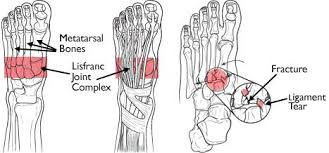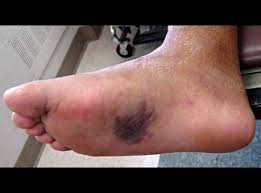The Lis-Franc injury is defined as a bony or ligamentous injury involving the midfoot and forefoot. It is named after a French surgeon and gynaecologist who described the injury in 1815 during the Napoleonic war. Many soldiers fell from their horses having there foot caught in stirrups. The fall resulted in an injury to the now known Lisfranc joint. In the 1800’s treatment involved amputation, however fortunately medicine has come along way

The Lisfranc joint is the keystone of the foot and allows you to transfer weight from your midfoot to forefoot. A subtle injury to this joint should never be taken lightly, as it plays such an important role in ambulation. If it is severe it may take months to heal and may require surgery. If it is subtle it will likely require a period of non-weightbearing in a moon boot.
Causes:
These injuries often happen due to a direct or indirect cause. A direct cause is relatively uncommon and occurs as a simple crush injury to the midfoot region. An indirect injury is more common and occurs with a simple twist and fall or when landing on the point of your toes.
Signs  and Symptoms
and Symptoms
– Pain at the top of the foot
– Swelling at the top of the foot
– Bruising at the bottom of the foot
– Pain is aggravated by walking on toes
– Widening of the foot and complete inability to weight-bear for severe injuries
Management
– Referral for imaging (MRI) will be necessary to determine the severity of the injury and to rule out/in any fracture or dislocation.
– Severe injuries will require surgery and your physio will take you through your rehabilitation.
– For mild sprains / subtle injuries of where the ligament is sprained immobilisation in a walking boot is necessary for 2-8 weeks. Depending on your pain levels you will be able to bear weight and progress through your rehab program catered to your chosen level of activity.
